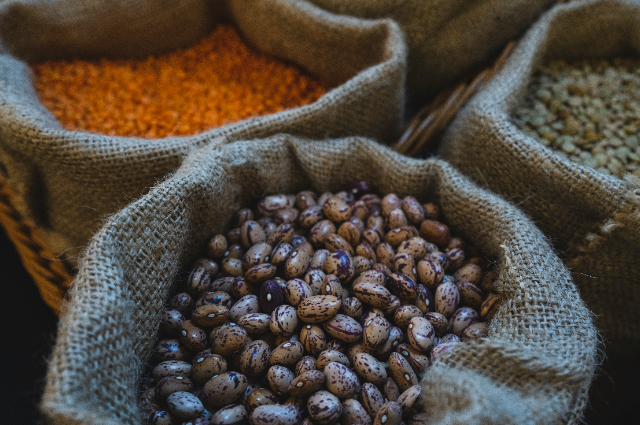
Photo by engin akyurt on Unsplash
Government sets ambitious targets as the Indian government has set its vision on achieving self-sufficiency in pulse production. This goal was recently reiterated by Union Minister Shivraj Singh Chouhan during a review meeting on Kharif crops.
Empowering Indian Farmers through Direct Procurement
In a significant move to make India self-sufficient in pulses, the government has launched a new portal that enables direct procurement of tur dal (pigeon pea) from registered farmers. This initiative launched by Union Home and Co-operation Minister Amit Shah aims to empower farmers and reduce India's reliance on pulse imports.
The newly launched portal facilitates the registration, purchase, and direct payment to farmers producing tur dal. This streamlined process ensures that farmers receive a fair price for their produce either at the minimum support price (MSP) or the market price, whichever is higher. This direct procurement model eliminates intermediaries by ensuring that farmers receive the maximum benefit for their hard work.
India's tur dal production is expected to reach 3.4 million tonnes in 2023-24, slightly lower than the record output of 4.8 million tonnes in 2016-17 due to reduced land. However, with this new initiative, the government estimates a significant decrease of over 35% in pulse imports in the ongoing fiscal year compared to the previous year.
Union Home and Cooperation Minister Amit Shah emphasized that India will no longer need to import pulses by January 2028. This ambitious goal is achievable through initiatives like the newly launched portal which empowers farmers and promotes self-sufficiency in pulse production.
The launch of this portal marks a significant step towards making India self-sufficient in pulses. By directly procuring from registered farmers, the government ensures fair prices and eliminates intermediaries. This initiative will not only benefit farmers but also reduce India's reliance on imports, making our country more self-sufficient in the long run.
Why Pulses Matter?
Pulses, such as lentils and chickpeas are a vital source of protein especially for vegetarians. They are also an essential part of a balanced diet and contribute to food security.
Increasing Pulse Cultivation
There's positive news on the ground. The area dedicated to pulse cultivation has risen significantly during the current Kharif sowing season with a particular increase in Tur/Arhar supply. This indicates a growing focus on pulse production.
Encouraging Farmer Participation
To further incentivize farmers, the government has committed to procuring 100% of Urad, Arhar and Masur pulses across all states. This policy aims to provide a guaranteed market and income for farmers who choose to cultivate pulses.
Spreading Awareness
The government acknowledges the need to raise awareness about the importance of pulse production. By educating farmers about the benefits of cultivating pulses and the government's procurement schemes, they aim to encourage even greater participation.
A Win-Win Situation
India's quest for pulse self-sufficiency is a positive development for both farmers and consumers. By increasing domestic production, the government aims to stabilize pulse prices and reduce dependence on imports. This will benefit consumers, while farmers will gain from assured markets and potentially higher incomes.
Ensuring a Smooth Kharif Season: A Look at the Minister's Review Meeting
- Focus on Kharif Crop Success: A recent meeting between the Union Minister and agricultural officials aimed to ensure a successful Kharif season. The discussions covered various aspects crucial for an open harvest.
- Monitoring Monsoon Progress: The meeting included a briefing on the progress of the monsoon, a vital factor for Kharif crops. Understanding monsoon patterns helps authorities plan and address any potential issues arising from delayed or unpredictable rainfall.
- Groundwater Assessment: Groundwater availability is another critical element for Kharif crops. Officials explained the minister of the current groundwater situation which provides insights into irrigation requirements and potential water stress areas.
- Seed and Fertilizer Availability: Ensuring adequate availability of seeds and fertilizers is essential for Kharif planting. The minister emphasized the importance of timely access to these inputs for farmers to adhere to sowing schedules.
- Focus on DAP Fertilizer: Discussions specifically highlighted the need for sufficient DAP fertilizer, a crucial nutrient for Kharif crops. The minister urged the fertilizer department to ensure supplies meet state demands and prevent shortages.
- Collaborative Approach: The meeting brought together representatives from various departments including agriculture, meteorology, water management, and fertilizers. This collaborative approach ensures all aspects of Kharif crop production are addressed effectively. By focusing on these critical factors, the minister's review meeting paves the way for a smooth Kharif season and a potentially fruitful harvest.
Boosting Pulse Production through Government Initiatives for Farmers: Encouraging Pulse Cultivation
The government is taking significant steps to enhance pulse production by motivating farmers to switch to growing pulses. This initiative is crucial as pulses are a key component of the Indian diet and their increased production can ensure better food security and nutritional balance.
Role of NAFED and NCCF
To make this transition smoother for farmers, the National Agricultural Cooperative Marketing Federation of India Ltd (NAFED) and the National Cooperative Consumer's Federation of India Ltd (NCCF) are spearheading pre-registration campaigns. These organizations are working together to support farmers in their shift towards pulse cultivation, particularly focusing on the upcoming Kharif season.
Preparing for Kharif Sowing
The pre-registration drives are designed to equip farmers with the necessary resources and knowledge well ahead of the Kharif sowing season. By registering in advance, farmers can access various benefits and support systems by ensuring they are fully prepared to cultivate pulses effectively.
Success in Madhya Pradesh
Madhya Pradesh has seen a notable response to these initiatives. A total of 8,487 Urad farmers have registered through NCCF and NAFED. This significant number indicates a positive response to the government's efforts and a strong move towards increasing pulse production in the region. Overall, the government's strategy to promote pulse cultivation through pre-registration drives by NAFED and NCCF is a commendable effort. It not only supports farmers in adapting to new crops but also aims to enhance food security and nutritional standards across the country.
. . .
References:
